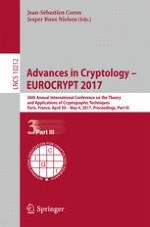2017 | OriginalPaper | Buchkapitel
Scrypt Is Maximally Memory-Hard
verfasst von : Joël Alwen, Binyi Chen, Krzysztof Pietrzak, Leonid Reyzin, Stefano Tessaro
Erschienen in: Advances in Cryptology – EUROCRYPT 2017
Aktivieren Sie unsere intelligente Suche, um passende Fachinhalte oder Patente zu finden.
Wählen Sie Textabschnitte aus um mit Künstlicher Intelligenz passenden Patente zu finden. powered by
Markieren Sie Textabschnitte, um KI-gestützt weitere passende Inhalte zu finden. powered by
